Cork Flooring
If you’re planning any upcoming home renovations, consider cork flooring as the main material for the floors. Produced from pre-consumer recycled cork, you can find cork flooring in all different shades, colors and textures to fit your style.
According to Candice Olson, host of HGTV's Divine Design and Candice Tells All, "Cork flooring is the ultimate choice for style-savvy consumers because of its exquisite design possibilities, durability, reliability and eco-friendly features."


Make Your Own Cleaner
Think about how much money you spend on glass cleaner in a year. Save some money and ditch the chemicals typically found in store bought glass cleaners by making your own.
Jenny Realo, a personal finance expert and executive vice president of CareOne Services Inc., suggests the following tip: “Instead of buying glass cleaner for upwards of $5 or more, you can make a simple glass cleaner for 50 cents. Mix 2 cups of white vinegar with 2 cups of water and put it in an inexpensive spray bottle. Wipe with newspaper for a streak-free shine.”
And for furniture polish, Realo says, “All it takes 3 tablespoons water, 2 teaspoons olive oil (or any oil you have around the kitchen), and 4 tablespoons white vinegar.”
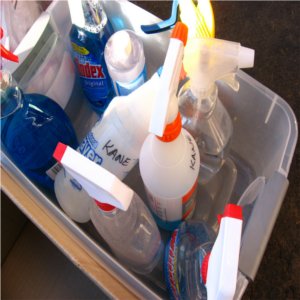
Replace Shower Head
Replace your existing showerhead with a 2.5 gallon per minute head – it uses less water and will save you around$145 per year in energy costs, according to the Department of Energy.
While commuting to work is a must for many, try to find alternative methods of transportation to save big on fuel costs and damage to the environment.
“Consider walking, biking, carpooling or taking public transit to work -- even one day a week will make a difference. An average midsize car on a 10-mile roundtrip commute emits nearly 8 pounds of carbon dioxide into the atmosphere, at a price of at $1.45 per trip in gas alone. Eliminating the drive one day per week will save 400 pounds of carbon and $72.50 per year,” says Kevin Gallegos, vice president of Phoenix operations with Freedom Debt Relief, LLC.
Purchase a Stainless Steel Water Bottle
Have you ever realized how many water bottles you purchase every year? In fact, some 2.7 million tons of plastic are used annually to make water bottlesthroughout the world. Stop wasting money on disposable water bottles, which end up sitting in a landfill for years once you throw them in the garbage.
Instead, purchase a stainless steel water bottle, as recommended by Chris and Kristen Conn who founded MightyNest.com. Not only will you eliminate the exorbitant expense of buying cases of bottled water, you’ll help limit the amount of garbage and waste in landfills – a huge plus to our environment.
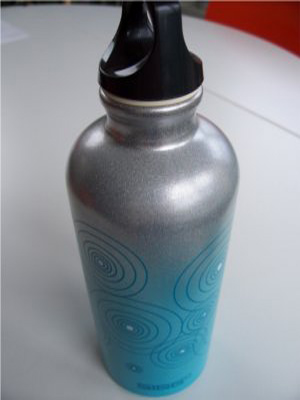
Turn Your Electronics Off
Did you know that even if you turn off your computer, unless you unplug it, electricity will still be used? So-called vampire power is sucked out even when your gadgets are not in use. While unplugging electronics isn’t going to save you thousands of dollars, it takes a half a second to unplug something, so why not?
According to Realo, “This little bit of savings each day can add up to savings of $15 to $20 a month on the average family’s electric bill –that’s a savings of $180 to $240 a year.”

Compact Fluorescent Lights
Consumers tend to be skeptical about whether or not Compact Fluorescent Lights (CFL) actually save money. Here are the numbers according to the Department of Energy: CFLs use 75% less energy than the traditional incandescent lights and will save $40 in energy costs throughout the life of the bulb.
You can purchase a CFL bulb for under $10, but this data suggests that the energy savings will pay for the cost of the CFL (which is usually more expensive than the incandescent bulb) in a few years.
CFL bulbs also generate less heat, which can save you money in the summer when you’re using energy to cool your home with air conditioning.

Purchase a Programmable Thermostat
Heating your home is a must when you’re actually in your home, but when you’re at work all day and no one is in the house, there’s no need to keep the heating or air conditioning on. By purchasing a programmable thermostat (usually less than $150, according to Realo), you can determine the appropriate times of the day when you want the heat/air conditioning to turn on or off. This results in an annual savings of $180 according to the Department of Energy.
The programmable thermostat will automatically adjust the temperature of the house at your command. If you don’t want to spend money on a new programmable thermostat, you can still turn off or lower the heat each day in the winter before you leave for work.
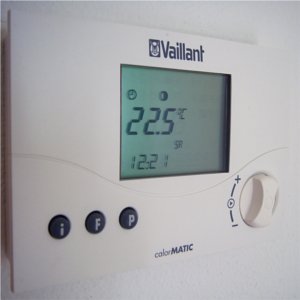
Look for the ENERGY STAR Label
When purchasing an appliance, always look for the blue "Energy Star" label. Products bearing the label must meet specific standards set by the government: In order for a product to display the label, it must help consumers save energy.
The goal of the label is to assist consumers in choosing the most “energy-efficient products” as explained on EnergyStar.gov.

Window Treatments
Aside from the aesthetic appeal, window treatments can save you money on home energy costs. During the summer months, close the blinds or curtains on your windows to prevent the sun’s energy from further heating your home. And during the winter, keep those curtains open to allow the sun’s natural light to help heat your home, which will put less stress on your heating system.
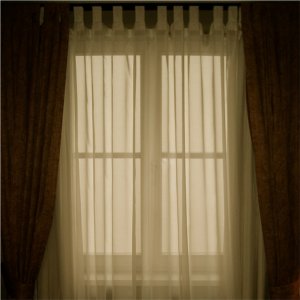
If you’re planning any upcoming home renovations, consider cork flooring as the main material for the floors. Produced from pre-consumer recycled cork, you can find cork flooring in all different shades, colors and textures to fit your style.
According to Candice Olson, host of HGTV's Divine Design and Candice Tells All, "Cork flooring is the ultimate choice for style-savvy consumers because of its exquisite design possibilities, durability, reliability and eco-friendly features."


Make Your Own Cleaner
Think about how much money you spend on glass cleaner in a year. Save some money and ditch the chemicals typically found in store bought glass cleaners by making your own.
Jenny Realo, a personal finance expert and executive vice president of CareOne Services Inc., suggests the following tip: “Instead of buying glass cleaner for upwards of $5 or more, you can make a simple glass cleaner for 50 cents. Mix 2 cups of white vinegar with 2 cups of water and put it in an inexpensive spray bottle. Wipe with newspaper for a streak-free shine.”
And for furniture polish, Realo says, “All it takes 3 tablespoons water, 2 teaspoons olive oil (or any oil you have around the kitchen), and 4 tablespoons white vinegar.”

Replace Shower Head
Replace your existing showerhead with a 2.5 gallon per minute head – it uses less water and will save you around$145 per year in energy costs, according to the Department of Energy.
By the way, if you have a leaky faucet, it’s a good idea to fix it because leaky faucets cost $35 every year in energy costs, based on data from the Department of Energy.
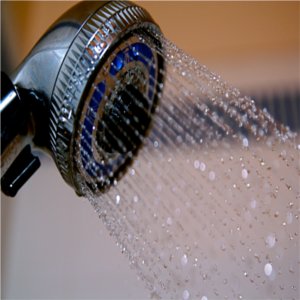
Commute Less

Commute Less
While commuting to work is a must for many, try to find alternative methods of transportation to save big on fuel costs and damage to the environment.
“Consider walking, biking, carpooling or taking public transit to work -- even one day a week will make a difference. An average midsize car on a 10-mile roundtrip commute emits nearly 8 pounds of carbon dioxide into the atmosphere, at a price of at $1.45 per trip in gas alone. Eliminating the drive one day per week will save 400 pounds of carbon and $72.50 per year,” says Kevin Gallegos, vice president of Phoenix operations with Freedom Debt Relief, LLC.
 |
| Hard to do when most employers shun those who use Public Transit, and some States have removed it instead of adding it. |
Purchase a Stainless Steel Water Bottle
Have you ever realized how many water bottles you purchase every year? In fact, some 2.7 million tons of plastic are used annually to make water bottlesthroughout the world. Stop wasting money on disposable water bottles, which end up sitting in a landfill for years once you throw them in the garbage.
Instead, purchase a stainless steel water bottle, as recommended by Chris and Kristen Conn who founded MightyNest.com. Not only will you eliminate the exorbitant expense of buying cases of bottled water, you’ll help limit the amount of garbage and waste in landfills – a huge plus to our environment.

Turn Your Electronics Off
Did you know that even if you turn off your computer, unless you unplug it, electricity will still be used? So-called vampire power is sucked out even when your gadgets are not in use. While unplugging electronics isn’t going to save you thousands of dollars, it takes a half a second to unplug something, so why not?
According to Realo, “This little bit of savings each day can add up to savings of $15 to $20 a month on the average family’s electric bill –that’s a savings of $180 to $240 a year.”

Compact Fluorescent Lights
Consumers tend to be skeptical about whether or not Compact Fluorescent Lights (CFL) actually save money. Here are the numbers according to the Department of Energy: CFLs use 75% less energy than the traditional incandescent lights and will save $40 in energy costs throughout the life of the bulb.
You can purchase a CFL bulb for under $10, but this data suggests that the energy savings will pay for the cost of the CFL (which is usually more expensive than the incandescent bulb) in a few years.
CFL bulbs also generate less heat, which can save you money in the summer when you’re using energy to cool your home with air conditioning.

Purchase a Programmable Thermostat
Heating your home is a must when you’re actually in your home, but when you’re at work all day and no one is in the house, there’s no need to keep the heating or air conditioning on. By purchasing a programmable thermostat (usually less than $150, according to Realo), you can determine the appropriate times of the day when you want the heat/air conditioning to turn on or off. This results in an annual savings of $180 according to the Department of Energy.
The programmable thermostat will automatically adjust the temperature of the house at your command. If you don’t want to spend money on a new programmable thermostat, you can still turn off or lower the heat each day in the winter before you leave for work.

Look for the ENERGY STAR Label
When purchasing an appliance, always look for the blue "Energy Star" label. Products bearing the label must meet specific standards set by the government: In order for a product to display the label, it must help consumers save energy.
The goal of the label is to assist consumers in choosing the most “energy-efficient products” as explained on EnergyStar.gov.

Window Treatments
Aside from the aesthetic appeal, window treatments can save you money on home energy costs. During the summer months, close the blinds or curtains on your windows to prevent the sun’s energy from further heating your home. And during the winter, keep those curtains open to allow the sun’s natural light to help heat your home, which will put less stress on your heating system.

No comments:
Post a Comment